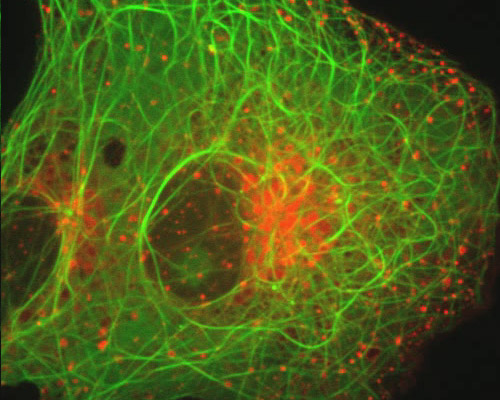Monkey Kidney Cells with mEmerald-MAP4 and mCherry-Rab5a

This collection of digital video sequences explores the dynamics of endosomes in relation to the intracellular microtubule network in African green monkey kidney fibroblast cells (CV-1 line). It has been found that over-expression of MAP4 stabilizes microtubules during every phase of the cell cycle in human leukemia cells and causes a potent mitotic block and a previously unobserved phenotype distinguished by large monastral spindles. Co-expression of catastrophe-promoting or tubulin-sequestration-specific Op18 derivatives was proven to adjust the action of ectopic MAP4 during mitosis, but with differing degrees of functional outcome.
Endosomes in the cells were visualized with mCherry fused to Rab5a, which is a Ras related protein useful in microscopy as a marker of early endosomes. Members of the Rab family of proteins primarily function in various aspects of vesicle trafficking and signaling within the cell. About 70 Rab proteins have been found thus far in human cells. Microtubules in the featured cells were tagged with mEmerald fused to MAP4, a microtubule-associated protein.
The red fluorescent protein mCherry was developed in the lab of Roger Tsien through directed mutagenesis of mRFP1, a monomeric DsRed mutant. Peak excitation and emission of mCherry occur at 587 and 610 nanometers, respectively. As its name suggests, mEmerald is a green fluorescent protein. The variant of Aequorea-based EGFP experiences peak excitation at 487 nanometers and peak emission at 509 nanometers.



